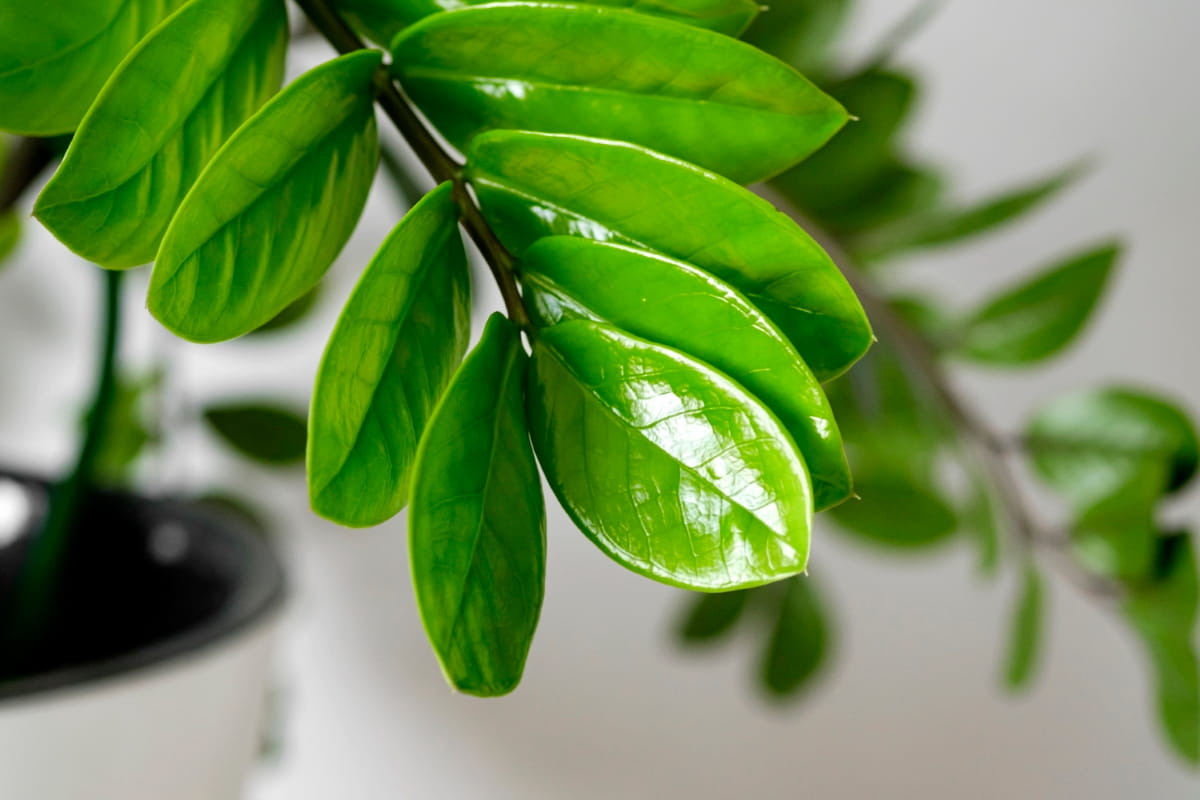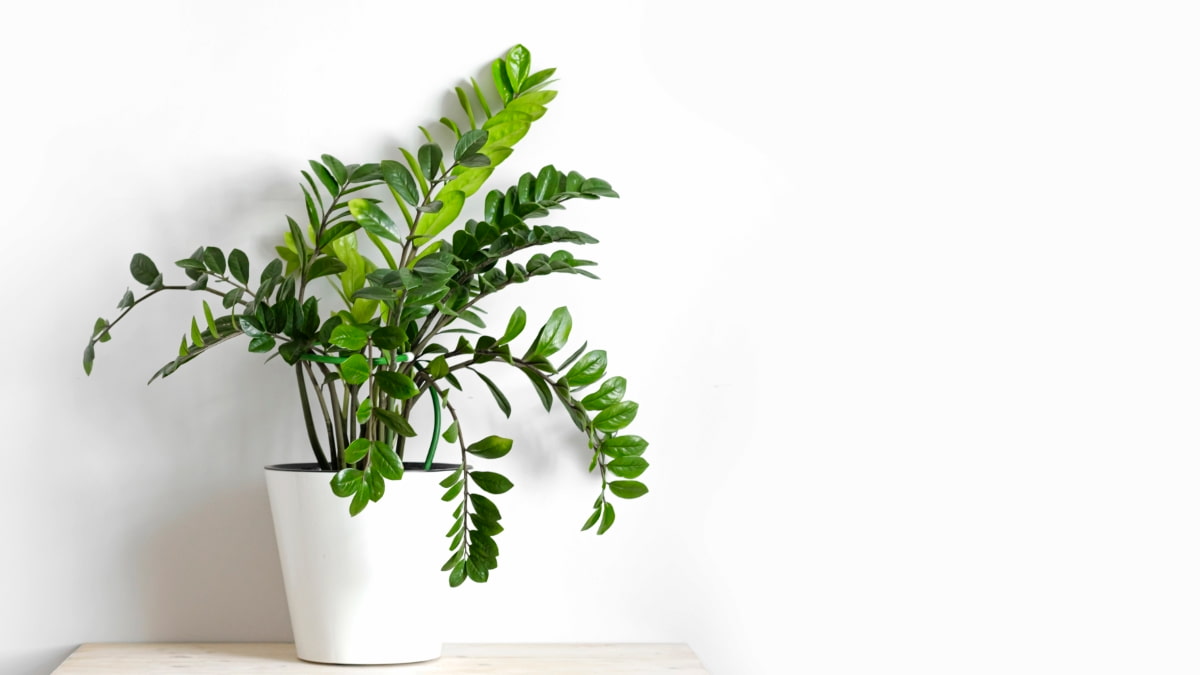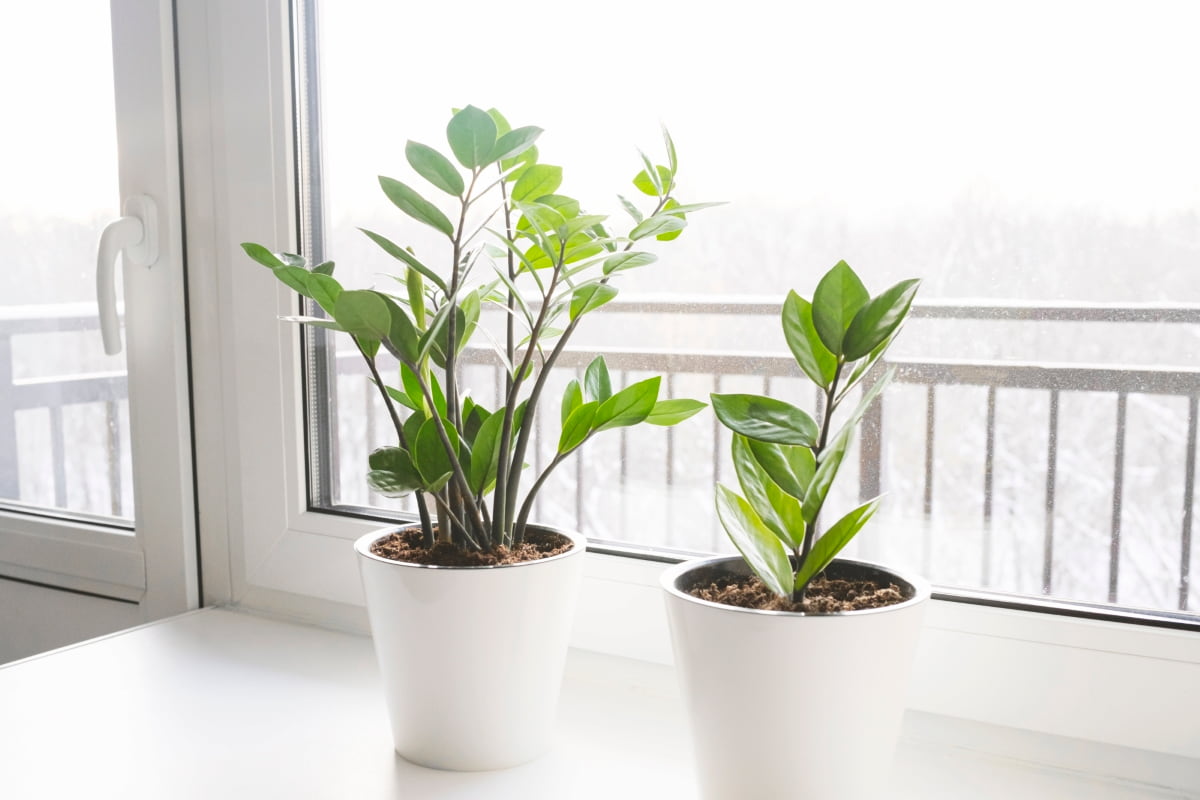ZZ plant, scientifically known as Zamioculcas Zamiifolia, is a flowering plant that belongs to the family Araceae. Successful ZZ plant propagation requires attention to detail and proper care. It’s important to use clean tools when taking cuttings, provide adequate light and humidity, and ensure proper watering techniques.

ZZ Plant Propagation Methods
- Leaf-cutting – Cut a leaf from the plant into sections, ensuring each section has a vein running through it. Then, place the cuttings in a moist potting mix or water until they develop roots.
- Water propagation – ZZ plant water propagation involves taking stem cuttings with at least two nodes and placing them in water until roots form. Once the roots are established, you can transfer the cuttings into the soil.
- Division – This involves separating the plant into smaller sections by carefully dividing the rhizomes or underground stems. Each divided section should have its own set of leaves and roots.
- Stem cutting – Choose a healthy stem with several leaves intact and make a clean cut below a node. Remove lower leaves from the cutting before planting them in soil or water.
How to Propagate ZZ Plants?
Propagation may take time and patience, but experimenting with different methods can be rewarding when you see new growth emerging from your propagated ZZ plants. Ensure proper care, like adequate light levels, appropriate watering routines, and suitable temperatures after propagation, to ensure successful establishment.
Best Practices for Propagating ZZ Plants
Choose a healthy and mature plant as the parent plant for propagation. This will ensure that the cuttings or divisions have sufficient energy reserves to establish themselves. Make sure to use clean and sharp tools when taking cuttings or dividing the plant. Additionally, provide indirect but bright light to encourage root development and growth.
Maintain consistent moisture levels during propagation by watering. Overwatering can lead to rotting, while underwatering may cause stress on new roots. Be patient with your propagated ZZ plants as they take time to establish themselves. Avoid disturbing them too often and allow them enough time before repotting or transplanting into larger containers.
Leaf Cutting Propagation of ZZ Plants
Leaf-cutting propagation is one of the easiest and most common methods for propagating ZZ plants. It involves taking a leaf from a mature plant. Choose a fully grown leaf free from any damage or disease. Using scissors, carefully cut the leaf at its base where it meets the stem. Ensure to include a small section of the stem with the leaf to aid in rooting. Once you have your cutting, allow it to dry out for several days before planting.
In case you missed it: How to Treat Brown Spots on ZZ Plant Leaves Naturally: Causes, Fix with Effective Home Remedies

This helps to prevent rotting and promotes successful root development. After drying, place the cutting in well-draining soil or water. If using soil, insert the cutting base into a small hole with your finger or pencil. Gently firm down the soil around it to ensure good contact. Keep your newly propagated ZZ plant in indirect light and maintain consistent moisture levels while avoiding overwatering.
Water Propagation of ZZ Plants
How to propagate the ZZ plant? Water propagation is a simple and effective method to propagate ZZ plants. It involves placing the cuttings in water until they develop roots. To start, choose a healthy stem cutting from your ZZ plant. Ensure it has at least two leaves and a node where the roots will form. Fill a glass or container with clean water, covering about an inch of the stem cutting.
Change the water weekly to prevent bacterial growth and ensure oxygen supply to the developing roots. In about 4-6 weeks, you should see small white roots emerging from the nodes of your ZZ plant cuttings. Once the roots have developed to a reasonable length (around 1-2 inches), you can transfer them into potting soil or any well-draining medium you choose. Be gentle when transplanting to avoid damaging the fragile new roots.
Division Propagation Technique for ZZ Plants
The division propagation method involves separating the rhizomes or underground stems of the plant into smaller sections, each with its roots and foliage. To propagate a ZZ plant through division, start by carefully removing it from its pot. Dividing the rhizomes into sections using a sharp knife or scissors ensures each section has at least one healthy stem and sufficient roots. Next, replant each divided section in its container filled with well-draining potting mix.
Make sure to position them at the same depth as originally planned. Water thoroughly after dividing and repotting to encourage root growth. Place the newly divided plants in an area with bright indirect light and maintain regular watering until they establish themselves. Division propagation is best done during spring when new growth begins to emerge. It allows you to create multiple ZZ plants from one parent plant, making it an economical way to expand your collection.
Propagating ZZ Plants from Stem Cuttings
This involves taking a healthy stem from an established plant and encouraging it to develop roots and grow into a new plant. To propagate the ZZ plant stems, choose a mature stem about 6-8 inches long. Ensure the stem has at least two or three leaves attached. Once you have your cutting, remove any lower leaves near the bottom of the stem so that only one or two sets of leaves remain. This will help reduce moisture loss while the cutting develops roots.
In case you missed it: How to Grow and Care for ZZ Plants: Planting Instructions

You can use perlite, vermiculite, or a combination of these materials with regular potting soil. Moisten the soil slightly before planting your cutting. Make a hole in the soil using your finger or pencil and gently insert the cutting into it up to its first set of remaining leaves. Place your potted cutting in indirect light or filtered sunlight. Avoid direct sunlight, which can scorch young foliage and develop root systems. Remember that not all cuttings will successfully root, so don’t get discouraged if some fail to thrive.
Rooting ZZ Plant Cuttings in Water
To start, select a healthy stem or leaf from your ZZ plant. Make a clean cut below a node using a clean pair of pruning shears. Fill a glass or jar with filtered water and place the cutting inside, ensuring that at least one node is submerged. It’s important to use filtered water as tap water may contain chemicals that can hinder root development.
Place the glass or jar in an area with bright, indirect light. Change the water every few days to keep it fresh and oxygenated. It may take several weeks for roots to develop. You can transfer the cutting into potting soil once you see new growth and well-established roots.
Growing ZZ Plants from Leaf Cuttings
Select a healthy leaf from the ZZ plant. Look for a mature leaf fully grown and free from damage or disease. To propagate the ZZ plant from the leaf using scissors, carefully cut it at its base where it meets the stem. Once you have your cutting, allow the end to dry out for a few hours. This will help prevent rotting when you place it in soil or water for rooting. After drying, dip the cut end of the leaf into rooting hormone powder if desired – this can help stimulate faster root growth.
Next, prepare a small pot filled with well-draining potting mix. Ensure the soil is moist before inserting your cutting into it. Gently push the cut end of the leaf about an inch deep into the soil so that it stands upright. Place your potted cutting in a warm and bright location without direct sunlight. Keep the soil consistently moist by misting regularly or using bottom watering techniques. Within several weeks to months, roots should start forming from the base of your cutting.
Tips for Successful ZZ Plant Propagation
- Choose healthy parent plants: When propagating ZZ plants, starting with healthy parent plants is important. Look for leaves that are free from any signs of disease or damage.
- Use a well-draining soil mix: ZZ plants prefer a well-draining soil mix that allows excess water to flow away from the roots. Consider using a combination of potting soil and perlite or pumice for better drainage.
- Maintain optimal humidity levels: ZZ plant propagation requires slightly higher humidity than mature plants. You can increase humidity by misting the cuttings regularly or placing them inside a plastic bag until they root.
- Keep temperatures consistent: ZZ plant cuttings prefer warm temperatures between 18-24°C. Avoid exposing them to cold drafts or extreme temperature fluctuations.
- Be patient and avoid overwatering: Overwatering is one of the most common mistakes when propagating ZZ plants.
In case you missed it: How to Grow ZZ Plant from Cuttings: DYI in 10 Simple Steps

Conclusion
The ZZ plant’s unique foliage features dark green, shiny leaves that grow alternately along its stems. The ZZ plant is a versatile and easy-to-care-for plant that can bring greenery to any space. Its glossy leaves and unique appearance have become increasingly popular among plant enthusiasts.
- Feed Your Flock for Less: Top 10 Tips to Save on Chicken Feed
- Ultimate Guide to Ossabaw Island Hog: Breeding, Raising, Diet, and Care
- Hatching Answers: The Top 10 Reasons Your Chickens Aren’t Laying Eggs
- Eggs and Economics: Breaking Down the Cost of Raising Backyard Chickens
- Defend Your Greens: Proven Methods to Keep Iguanas Out of Your Garden
- Ultimate Guide to Cinnamon Queen Chicken: A Comprehensive Guide for Beginners
- Ultimate Guide to California Tan Chicken: Breeding, Raising, Diet, Egg-Production and Care
- Ultimate Guide to Marsh Daisy Chicken: Breeding, Raising, Diet, and Care
- 10 Types of Chicken Farming Businesses You Can Start for Profits